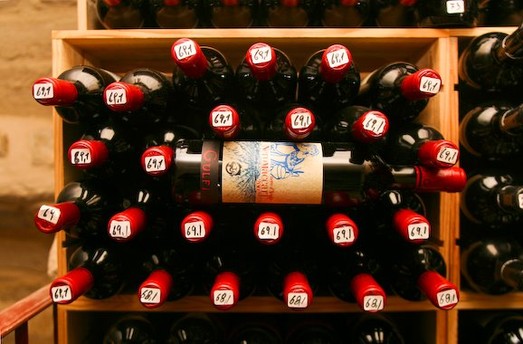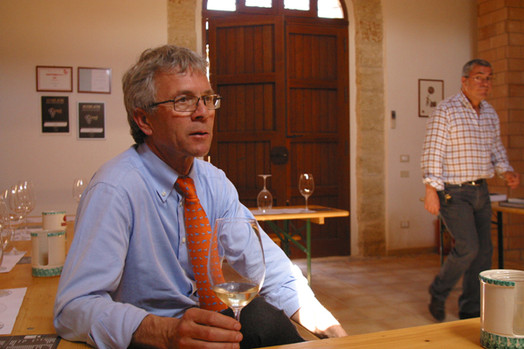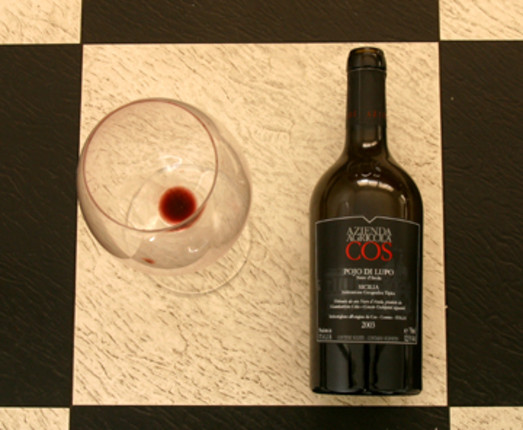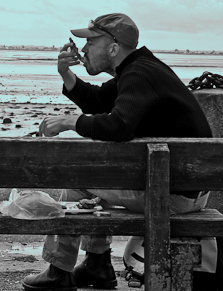Joe Ray
Food & Travel / Words & Photos

Friday, June 06, 2008
Standing up for an old friend
A year ago, Francesco and I would sit in the office at the end of a long day, uncork a bottle of Nero d’Avola and work on gaining a better understanding of the characteristics of Sicily’s best-known grape. Professional wine tastings can be a bit force fed – a winemaker might quickly say what you should be seeing, smelling and tasting. Picking these characteristics out on your own inevitably forces you to go slower than they guy at the front of the room. Taking the time to really understand just one wine is a luxury. And you can really learn something.
A year later, I learned something different.
“Nero,” says Francesco, making a diving motion with his hand, “is having a tough time.”
We opened a 2006 Nero di Lupo (a 2003 version of which we tasted last year when it was called Pojo di Lupo) and talked about it.
“Traveling in Italy and abroad, I started to notice its absence in the last couple of months,” says Francesco.
At Milan’s best wine shop, the owner put it to him bluntly. “Nero d’Avola? It’s over.”
The Nero di Lupo name change was a clue; after a several-year run as one of Italy’s trendiest wines, everybody wanted a piece of wines made with Nero. Producers started growing the grape in regions less suited to its production - often far from Avola. Though quality winemakers are still making excellent wines, the bottom of the market has been flooded, dragging the good wine’s good name down with it.
“It’s been sold improperly,” says Sicily’s top chef, Ciccio Sultano, who is upset with both rising Nero prices and an overall quality decline. “Demand grew, but the wineries multiplied…It’s too much.”
“Take Bordeaux - it’s crazy,” he says, pointing to his head, “you can’t justify the price. It’s for the Russians.
“What’s the difference between this and a Mouton Rothschild?” he asks, holding up a glass. “Is that 30 or 40 times better? It’s marketing. Wine is like a cuisine – there is art and craftsmanship, but it’s outrageous to pay too much for food and wine.”
Luckily, the good stuff is still out there. Though it took our Nero di Lupo three hours to open up (why they consider this stuff currently ready to sell at a grocery store is beyond me).
Once it was ready, it was a beautiful thing, full of autumn leaves along with more typical leather, licorice and berry smells. Flavors of orange zest and chocolate emerge.
“Eureka!” deadpans Francesco. “Sometimes, we face hard times in drinking.”
A few days later, after sitting in on an almond tasting with sensorial analyst, Giuseppe Cicero, the good doctor broke out a bottle of Terra delle Sirene, clearly one of his favorites.
Big, a little brash and quite tasty with almonds, this was the wine I remembered going nuts for last year.
“It’s not hard to find good red wine among the Sicilian wineries,” says Cicero who’s partial to one made by Rosso Del Conte.
We’re just going to have to do a little more homework.
This is Joe Ray reporting from the Motherland.
Saturday, May 31, 2008
A mouthful of memory
Yesterday, I interviewed a farmer in his Ferrari for a story about the Sicilian melon market. Taking notes in a car with a suspension-adjusting switch marked “RACE” is not unlike trying to do the same in a 4x4 bumping through an olive grove.
Meeting a couple of melon farmers yesterday, Mr. F430 included, I kept getting distracted by their tomatoes. Odd bedfellows, melons and tomatoes love the soil and hot climate around the southern Sicilian town of Pachino and have become the town’s financial backbone and its claim to fame.
Standing in a giant tomato greenhouse filled with the wonderful green smell of the vines themselves, Bruno Cicciarella (who drives a more modest ride pulls a fat thumb-shaped tomato he calls a ‘pixel’ from a cluster and hands it to me.
The taste isn’t perfect, but compared to what we’ve grown accustomed to from the grocery store, it’s mind blowing. It’s plenty enough to put me out on the back deck with my family, eating salted chunks of dad’s tomatoes straight from the garden.
I also try some tomatoes sold by Sebastiano Fortunato (a.k.a. Mr. Ferrari) and understand why he’s got such a fancy pair of wheels. His cherry tomatoes are so sweet, it’s easy to understand again why tomatoes are fruit.
Later, Francesco and I have a great glass or two of Sicily’s signature Nero d’Avola wine in my kitchen. It’s good reminder of why he and I spent a lot of time with our noses in glasses and turning our tongues purple a year ago trying to learn the flavor characteristics that make it such a good pour.
“Why do we have to be so technical when we try to describe a wine?” he wonders to no one in particular. It’s a fun question and a debate for which he knows and appreciates the arguments of both sides. “Why can’t we say this wine tastes like…The Police?” he asks, clearly thinking back to a good moment where he had the British trio on in the background.
In the end, what better compliment could you give than associating good food with a good memory?
I end the night with one of Cicciarella’s tiny melons. It’s a mouthful of summertime, past and present.
This is Joe Ray reporting from the Motherland.


Wednesday, May 09, 2007
The Name On The Bottle
I meet Calogero at his Palermo office, but his heart has already left for the hills.
So we follow.
A lawyer by day and a wine producer whenever he has a spare moment, Calogero Leone runs his vineyard on property his family has owned for some 200 years.
It’s hard to imagine that countryside this beautiful exists so close to Palermo, a city where green space is rare and one of the best-known parks is covered in asphalt.
Though Leone grows and sells enough grapes (without turning them into wine) to employ several people, he only completes the process and puts his name and the vineyard’s – Tenuta Mariano – on 5,000 bottles per year, a paltry five percent of what he grows.
He takes me out into the vines to show me how they are slowly turning the family business from a quantity to a quality production. Several workers are out between the rows, already trimming back a good hunk of the new growth.
“Cutting back like this means we make 50 percent less wine but the quality is better,” he says. “Unfortunately, there isn’t a direct correlation between lower volume and a higher selling price.”
He’s a stickler for quality.
“We started the changeover in 2000 and have had two years where we didn’t produce,” he says.
So… in seven years of existence, there were two years where you bottled no wine?
“It wasn’t good enough.”
Later, as we head to meet a producer/friend of his, I ask why he wanted to make this switch.
The first few minutes of his reply seem to be the Sicilian version of vintner babble, but as we drive through the rapidly changing countryside, he lets me in a bit.
“As you get older, you encounter difficult situations, even pain,” he says. “I now prefer a quality of life that gives value to things.”
We pull into the Ceuso vineyards in Calatafimi Segesta, a small- to mid-sized producer run by the Melia brothers and their geologist brother in law.
“He does the accounting,” clarifies Vincenzo Melia (left), the agronomist.
Vincenzo is clearly distressed by something that happened just before our arrival and his shoulders don’t relax until he opens a bottle of their white wine and its smells (pineapple, most notably) drift across the tasting room.
He picks up on Calogero’s vein of the quality that a smaller producer can give to their wines.
“You can make wine more economically if you’re a big producer,” he says, waving his arms in a mix of exasperation and relief, “but the little producer can make more animated wines that have more soul.
“I prefer to sell my wine with my name on it.”
This is Joe Ray reporting from the Motherland.

Wednesday, February 07, 2007
Rock & Avola in The Motherland
We have been threatening to seriously taste some wines together since I got here. Tonight, we made good on the promise and I got a sort of Sicilian wine primer as a bonus.
I grabbed the wine from its display space next to its empty cousins on my kitchen floor and stole some big, beautiful tasting glasses from an undisclosed location. To keep the babes of Ispica at bay, we tasted in the office.
I put on some Green Day and Visqueen and we dove in.
The wine was a 2003 “Pojo di Lupo” – made entirely of one of Sicily’s best known grapes, the Nero d’Avola (Black from Avola), from the COS vineyard in the nearby town of Comiso.
We discuss the color – I say “ruby with a brown edge,” and F. says “pomegranate.”
“Is that ‘grenade?’” (like the French), I ask.
“Do you mean in Italian or Sicilan?” he replies.
“Either.”
“No.”
“Nero d’Avola is a grape that’s historically important to Sicily and in the last few years, has become trendy [in other parts of Sicily],” he explained. This latter part raises the hackles of the people in this neck of the woods, as they’d like to see it come from somewhere closer to Avola. Typically, this means towns within a tight radius – Ispica, at about 15 miles from Avola makes the cut, but Comiso, at 30, starts raising eyebrows.
Then again, Avola is the town with an Eiffel Tower replica next to a lit up jet fighter at a bend in the road.
The grape’s newfound popularity is a double-edged sword: Sicily finally gets some well-deserved recognition for making a great wine, but it also means that the number of morons out there making bad wine with good grapes increases.
The nose is where things got interesting.
In a tasting, I can usually tell when I’ve left France, but here things were very different.
“When you go from France to Sicily, it’s like going to Mars,” said F.
This certainly felt like an alien landscape, but a half hour of swirling and smelling before we took a sip began to bear fruit: for me, this wine had a smell of marinated cherries, then something that seemed to me to be mint or menthol that F. pegged as a woody balsamic smell. The last smell was the hardest to peg – somewhere between tea (it reminded me of mom’s Red Rose) and tobacco, the latter turning out to be one of the typical undertones in a Nero d’Avola. Woohoo! For someone like me who gets excited when I can pick one key element out of a wine when I’m really trying, getting three was exciting in a food geek kind of way.
In the mouth it tasted exactly like it smelled – how’s that for well-balanced?
This isn’t always the case, and it turned out to be one of the peculiarities of this producer’s version of the wine, for better and for worse. Nero d’Avola tends to be huge, and the producers reigned it in so much that the tobacco stood out and the big berry tastes that are its hallmarks didn’t even show up until we had the bottle open for a couple of hours.
That said, we finished the bottle; with wine that tends to be huge and full of alcohol (products of the Sicilian sun), you’re either ready to go to bed or chase Sicilian women after a glass or two.
At the end of the night, we switched music to some of F’s favorites - Gerry Mulligan, Steely Dan, and David Bowie doing a curious Beatles cover. Then Frank Sinatra came on and F. grinned, smiled, whistled and tapped his feet.
Which is exactly what should happen when you’re enjoying what you drink.
This is Joe Ray reporting from the motherland.
